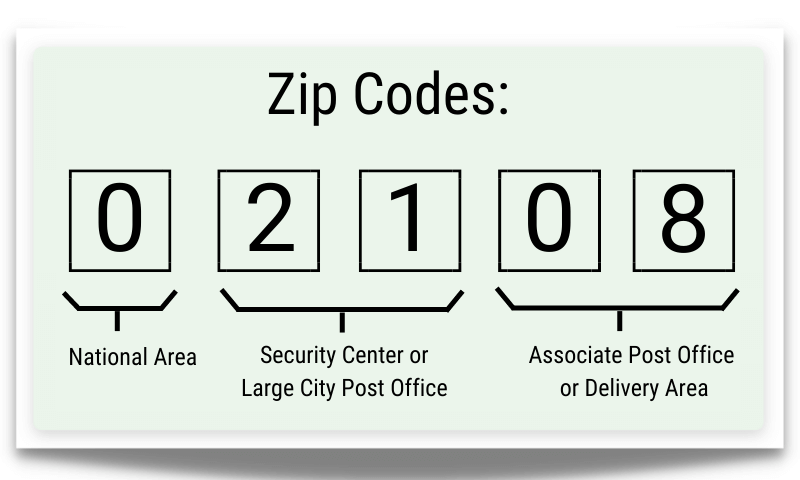Whether shipping a high-value package to a customer or a holiday card to a loved one, sending documents and packages from one place to another necessitates using valid address data for prompt and accurate delivery. The codes at the end of addresses, known as postal or zip codes, are crucial in helping mail carriers identify geographic locations, points of delivery, and mailing routes.
But if we examine these codes further, what is a zip code, what is a postal code, and how do they differ? In this article, we’ll break down the keynotes you want to know
What is a postal code?
Postal code meaning: A series of letters, digits, or both used in an address for mail sorting and delivery purposes.
Introduced in 1959, a postal code refers to the coding system used by various countries worldwide to simplify the processing and distribution of mail. This concept became practical in 1961 with the Nationwide Improved Mail Service (NIMS), which standardized mail sizes for mechanization. By 1963, the U.S. introduced the five-digit ZIP code under the USPS, later enhanced in 1983 with the ZIP+4 code to specify more precise locations.
Other countries, like Ukraine, adopted postal codes earlier, using them from 1932 until 1939. Germany followed in 1941 with two- and three-digit codes, while Singapore, Argentina, the United Kingdom, and Switzerland implemented their systems between 1950 and 1964.
How does a postal code work?
Whether a package is shipped within a state, across a given country, or to another country entirely across the world, the combinations of numbers (and sometimes letters) in a postal code form a specific identification code that allocates delivery points to a particular location. One postal code example is HP218R4.
Another postal code example is the zip code in the United States or the postal addresses in the United Kingdom and Canada, which typically have six characters and contain numbers and letters.
It’s important to note that the format and implementation of these codes vary depending on the specific geographical location they’re tied to, so postal codes will likely differ from country to country. Regardless of structure, the postal code aims to guarantee greater accuracy and efficiency in the exchange and delivery of mail.
What is a zip code?
Introduced in 1963, the United States Postal Service® (USPS) developed the zip code to denote the various individual post offices scattered across the country. The rapidly booming growth in the country meant a new system reliant on numeric value was essential to deliver mail vs. sticking to the traditional dependence on the recall of mere cities and states.
By 1967, all mail processed and delivered throughout the US had implemented the new zip code system. In the United States, zip codes are at least five digits long and represent an address's national area, region, city, and delivery area.
How does a zip code work?
Each digit in a zip code relates to identifying the address's location. The following zip code example breaks down the meaning behind each number.
- The first digit refers to the national area or defined group of states.
- The second and third digits signify a region, such as a large city within this group.
- The fourth and fifth digits represent a region's associate post office or delivery area.

These five digits are necessary to send mail within the US. Below, we’ll discuss adding plus-four codes for even greater mail delivery accuracy.
ZIP+4 Codes: a look at full zip codes
Most people are familiar with the five-digit zip codes described above. However, the growing need to enhance mail sorting and the delivery process meant additional information was needed to expand and develop this system further. Cue ZIP+4 – the additional four digits that act as an added identifier at the end of zip codes.
A regular zip code example would be five digits, such as 18235. However, a ZIP+4 code would look something like 18235-2239.
ZIP+4 codes notify the postal carrier of a geographic segment within a delivery area. These codes are affixed to a 5-digit USPS® Zip Code once the address has been validated and standardized, pinpointing an address down to a few block radius with maximum accuracy. These additional appended numbers further increase the precision of mail delivery.
Zip code vs postal code–how do they differ?
Although there are slight differences between a postal code vs. a zip code, they both serve a similar purpose: they append additional information to an address for fast and accurate mail delivery.
Is your Zip Code and postal code the same?
For citizens of the United States, a ZIP Code is the same as a postal code. A zip code refers to a type of postal code and is used primarily in the United States and the Philippines. The postal code, however, is typically utilized by the rest of the countries scattered throughout the world.
Unlike postal codes, which can contain a mixture of numbers and letters, zip codes only contain numeric values. Regardless of whether a country uses a postal code vs. a zip code, most countries use a coding system or other structure so users have rapid and efficient mail delivery.

Why zip code (and other address data) accuracy matters
With zip code information, business owners know their packages reach consumers accurately while reducing the risk of damage, delays, or further complications. However, they can only enjoy success when zip codes—and other key address information—are accurate.
At Experian, we give your business access to address verification tools that use fine-tuned technology to capture accurate data at the point of entry. Still not convinced?
See why businesses trust us to validate over 6+ billion requests each year.






